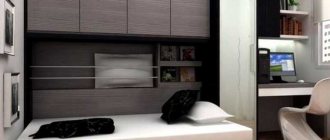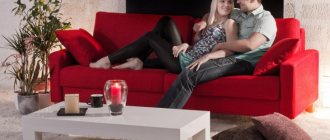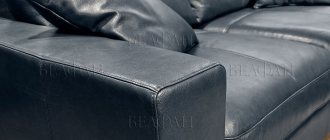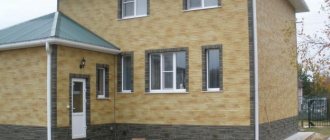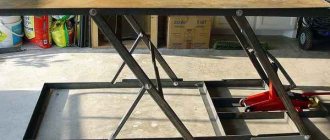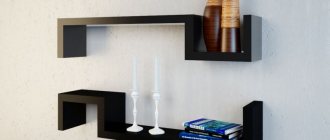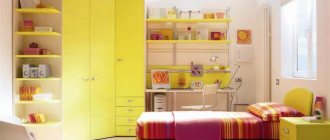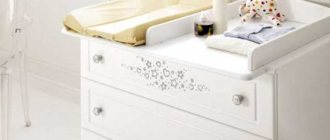The material and design of furniture facades determine how a particular design looks in the interior. But the quality of the fittings has a direct impact on the durability of the product. The range of these elements numbers in the hundreds, each of them performing a specific function. For example, when assembling any cabinet or sofa, furniture fasteners are required to connect the various parts. Thanks to the variety of its types, you can always choose the most convenient and cost-effective option. Even those who do not plan to install furniture themselves should pay attention to this type of fittings.
Confirmat
The most common and easiest to use type of furniture connection is the confirmat, which allows you to fasten several parts together at right angles .
In order to tighten furniture elements, you should drill 2 holes:
- the first - under the head of the confirmat (in one piece),
- the second - under the threaded part (in another part).
In this case, it is recommended to use drills with a diameter of six and five millimeters, respectively, or use a combination drill, which will significantly facilitate the procedure for assembling various sections of cabinet furniture.
As a rule, such fasteners are used to connect parts made of solid wood or chipboard (chipboards), and dowels are used in combination with it, acting as guides.
Confirmed fasteners
Confirmed fasteners
| Album | Confirmat |
Furniture confirmation
Furniture confirmation
| Album | Confirmat |
It is necessary to install the confirmat with great care, preferably manually, since when using a screwdriver there is a high probability that the thread will break the hole and the part will fall out during operation.
In addition, there are different types of fasteners, so after installing it you will need to use special plugs to hide it from prying eyes and give the furniture an aesthetic appearance.
Furniture corner
This type of fastener is used to connect two parts. This is a rather fragile connection method, so it is used to fasten parts that are not expected to be affected by heavy loads. Usually these are decorative elements, for example, the base of a wardrobe or mezzanine shelves.
Fig.21.
The furniture corner is used for fastening decorative furniture elements (plinth) and installing shelves. Made from plastic. It has a cover to hide the fasteners. Self-tapping screws 16 mm long are used as fasteners.
Plastic corners are often used instead of metal ones. They are no less durable, but have a more attractive appearance and the possibility of hidden fasteners. The furniture corner is attached to two mating parts using two self-tapping screws. Then the lid is snapped on, thus hiding the fasteners.
Fig.22.
A furniture corner is used for fastening low-load furniture elements, including for installing decorative elements such as a plinth, inserts, etc.
The furniture fasteners discussed in the article are the most common and most frequently used, due to the fact that these are the most versatile and easy-to-use types of fasteners. In the vast majority of cases, the types of furniture fasteners described are sufficient to assemble any furniture.
Eccentric coupler
This type of fastening element is used when assembling furniture in a factory environment, due to the complexity of drilling holes for its installation.
The main advantage of the eccentric screed is its concealability, which prevents the appearance of the cabinet or other cabinet furniture from being spoiled.
In addition, unlike the previous type of furniture screed, the presence of such elements allows you to carry out the procedure of assembling/disassembling interior items an unlimited number of times without damaging them, which, you see, is very convenient when moving frequently.
Also, using this fastening method, it is possible to fix the parts at an angle relative to each other.
As mentioned above, the installation of eccentrics is carried out in the conditions of factory furniture production, since the sampling depths for their installation are at least 12 millimeters. And this despite the fact that the wall thickness of the laminated particle board has a size of 16 millimeters. Therefore, without the use of special equipment, which is impractical to purchase for a one-time installation of interior items, installation of such fasteners is practically impossible.
What is a self-tapping screw and its purpose
A self-tapping screw is a special type of metal screw; in relation to wood, such a fastener is an element with a wider pitch of turns and a flat or sharp end.
Self-tapping screws are a popular type of fastener that has its own undeniable advantages.
In furniture stores you can find connecting elements with straight, Phillips or hex heads. To screw them in, you will need screwdrivers with the appropriate type of bits.
It is important to select fasteners based on the material and its density, thickness, etc.
Shelf supports
As you can guess from the name, such fasteners are used to fix shelves (both glass and plastic) of a wardrobe or kitchen cabinet.
Depending on the installation method, shelf holders are divided into open and hidden. The former are mounted directly to the pieces of furniture (after which a shelf is placed on them), while the latter are something like an eccentric coupler.
Shelf holders in the closet, photo:
The fittings that you see in the photo above are intended for attaching shelves in the closet.
Types of metal fasteners
The main purpose of furniture fasteners is to create a strong connection that adds strength to the furniture structure. Some types are used as point fixation, while others help create a kind of frame that will hold several elements together.
To date, several basic models of fasteners have been developed. These include:
- furniture corner. This element is designed to fasten two separate parts together. It helps to assemble all the parts into one design;
- confirmation These are ordinary bolts and screws for furniture paraphernalia;
- dowel It is a wooden retainer;
- screed;
- shelf holder;
- nuts and bolts.
Let's look at each category separately. The main characteristics of these parts will help you understand what these products are intended for.
Tabletop fasteners
A special type of furniture tie used to secure two parts of a tabletop together. It is used exclusively in the production of kitchen furniture and requires special milling of surfaces before installation.
Tabletop fasteners
Tabletop fasteners
| Album | Tabletop mount |
Tabletop mount
Tabletop mount
| Album | Tabletop mount |
Varieties
Use options depend on the purpose and design of the specific fastener. Next, we will look at the most common types of furniture screws and how to use them.
Euroscrew (confirmed)
Structurally, it is a cylindrical part with a countersunk head, in which there are slots for a hexagon or Phillips screwdriver. Directly behind the countersunk head is a smooth part, which should fit smoothly into the workpiece being pressed. The size of the smooth part varies and depends on the purpose of the particular screw. For example, the standard thickness of laminated chipboard (chipboard) is 16 mm. To properly attach one sheet of chipboard or a material of the same thickness, it is enough to use fasteners whose smooth part is 16 mm. For these tasks, furniture screws with a diameter of 7 mm and a length of 50-60 mm are most often used.
The application technology involves drilling workpieces. This is due to the characteristics of the material that is most often used in the furniture industry (chipboard). The thickness of the confirmat does not allow it to be screwed into a chipboard without drilling. The drill used in the process of preparing parts for joining has a special configuration and varies in diameter in different areas.
Theoretically, you can drill with three different drills:
- The largest radius is intended to make a countersunk under the head of the confirmat; in fact, this part of the tool does not make a hole, but only chamfers.
- Next, a hole is made in the workpiece being pressed; its diameter is equal to the smooth part of the Euroscrew (for example, 7mm).
- The thinnest hole is drilled into the part to which the previous one is pressed; its diameter is 5 mm.
It is not very convenient to work with three drills: you need to change them or have three drills in which the required diameter will be set. In addition, making a countersunk by hand with a drill is quite difficult. Taking these factors into account, one special drill was developed, which is used by modern furniture makers. When the preparatory work is completed, the workpieces are tightened together with screws. The tool for twisting the latter is selected depending on the design of the cap.
If the most popular confirmation size is 7x50 mm, then the most common spline configuration is a hexagon. The following tools are used to tighten hex screws:
- Hex bit, for use in a screwdriver, drill or screwdriver;
- L-shaped or Z-shaped hex key;
In addition to hex splines, there are also Phillips splines, but their use does not allow the parts to be tightened tightly enough, which leads to rapid loosening of the finished product.
Screw tie
It consists of two elements: a screw with an external thread and a barrel-nut with an internal one. During the joining process, the parts are positioned perpendicular to each other, that is, one workpiece with its flat side is pressed against the end of the other workpiece. A through hole is drilled in the pressed part, the diameter of which is slightly larger than the threaded part of the screw. In the workpiece to which the previous one is pressed, two holes are drilled: one at the end with the same diameter as in the part being pressed; the other on the flat side is for the barrel. The difficulty lies in the exact alignment of the end hole and the hole for the barrel.
Like the Euroscrew, the main use of this fastener is furniture production. By using a screw tie, you can achieve significant structural rigidity, which is not available when using any fasteners without metric threads, for example, confirmations or self-tapping screws.
The disadvantages of this connecting material are that it is difficult to install, requiring certain skills, and that the head of the furniture screw is visible from the outside. The last drawback can be partially hidden using special plugs, but this does not solve the problem completely.
Conical tie (mini-fix)
To install a conical tie, you do not need to drill through the part, which is attached with the flat side. The functioning mechanism is somewhat similar to a screw tie. The difference is in the fixation of the rod: it is attached not to a through hole, but to the flat part of the workpiece being clamped (after pre-drilling). The parts are fastened together by pressing the rod with a tie screw. This type of connecting elements is often used to attach a tabletop to a base or during the assembly of frame-type furniture facades.
Conical ties are also not easy to install; they require precise marking and drilling, which requires a highly qualified assembler. In addition, silumin used to manufacture the tension screw has a short service life, which significantly reduces the number of assembly/disassembly cycles of the finished product. In most situations, such a joint turns out to be disposable; in any case, for reassembly, the silumin tension screw will have to be replaced.
Shelf holders with fixation
This type of fastener is designed to hold shelves in furniture products. Its peculiarity is that, in parallel with its main purpose (support for shelves), it provides additional structural rigidity. The shelf holder consists of two parts: a rod and a support mechanism. The rod is screwed into the cabinet wall, and the support mechanism is installed directly into the shelf. During the assembly process, the rod must fit into the hook of the eccentric mechanism. After this, the shelf is attracted to the cabinet walls by turning the eccentric screw in the shelf holder.
This type of fittings is also not easy to install; it requires specialist skills and special equipment. In addition to marking and drilling, installation will require milling, which is best done in a workshop on a drilling machine.
Intersectional screed
Designed for connecting individual furniture modules. Essentially, it’s a bolt and nut, only in a more aesthetic design. The part of the tie that acts as a nut is made in the form of a hollow bolt (bushing) with an internal thread into which a movable tension element is screwed. During the assembly process, it is the screw (an element with an external thread) that needs to be tightened, and not the bushing, since it has slots that prevent it from turning in the laminated chipboard wall.
Quite easy to use and reliable, a furniture screw, usually made of high-quality metal, provides a rigid connection of individual sections in furniture production. Often used during the assembly of kitchen units, in particular wall cabinets. An intersectional screed turns individual cabinets into a solid monolithic wall, eliminating the occurrence of differences between kitchen units during operation.
Furniture screw with round or decorative head
Classic threaded connections are used for upholstered and cabinet furniture. There are several varieties of this fastener, the main distinguishing features of which are the design of the head and fixing elements. The screw is fixed in the particle board using a square headrest or slots. Such fasteners are quite convenient to use, since the nut can be screwed on without resorting to additional fixation of the screw itself. There are also options designed to be held with a screwdriver or hexagon.
Furniture screws are distinguished by size, material of manufacture and type of head. Let's take a closer look at each of the above types.
Semicircular
Decorative
To size
- The furniture screed is produced in accordance with the most commonly used material, that is, laminated chipboard, the thickness of which is 16 mm. Considering that the screed connects two plates drilled through, the length of one is 32 mm. This is the most popular size, but there are also 50mm length options;
- Euroscrew comes in thicknesses of 5, 6.3 and 7 mm. Moreover, its length can be 40, 50, 60 and 70 mm. Lengths of 60 and 70 mm are found only on 7 mm confirmats;
- The dimensions of the conical tie are standard: total length 44 mm diameter 6 mm;
- The length of the screw tie is 34 mm, while the diameter of the barrel is 10 mm, and the screw itself is 8 mm;
- The length and diameter of screws with a semicircular or flat head can be different and depend on the type of fixing element. For example, hexagon screws come with a diameter of 6 or 8 mm, length from 16 to 110. The maximum length of furniture bolts for a screwdriver or with a square headrest is 150 mm, while the standard diameter is 6 and 8 mm.
According to the material of manufacture
The purpose of this type of fastening materials is to fix furniture structures of varying degrees of rigidity. In addition, the finished product should look no worse than that of competitors. To achieve the optimal balance between the solidity of the structure and its appearance, the following materials are used:
- Metal fasteners made using carbon steel grades;
- Aluminum and its alloys (silumin) - used in screw elements of complex configuration, for example, a mini-fix lag screw;
- Brass is a more aesthetic and practical material. Used on visible areas of structures or in places with high humidity;
- Plastic is used as a body material in the seats of some types of ties, such as the shelf holder body;
Metal fasteners for furniture can be coated or uncoated (most often galvanized), but in any case, the products are regulated by GOST or other standards.
Based on the type of head, there are the following types of furniture screw heads:
- Spherical flat head without internal splines for retention with external locking tool. Typically, such fasteners have a square headrest or a fixing mustache. Basically all furniture screws are DIN 607;
- Spherical head for hex, flat or Phillips screwdriver. The most common representative of this type of fastener is a screw with a press washer DIN 967;
- Flat head for a Phillips or hex screwdriver, for example, a screw that complies with DIN7420 regulations;
- Countersunk head for a hexagon or Phillips bit (confirmations and some types of threaded fasteners).
Steel
Aluminum
Brass
